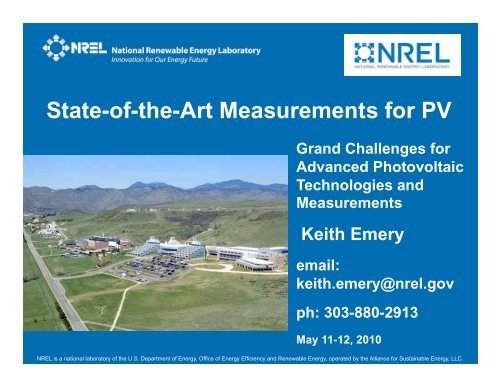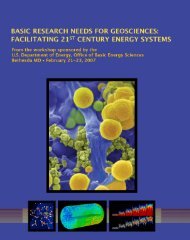State-of-the-Art Measurements for PV - Energetics Meetings and ...
State-of-the-Art Measurements for PV - Energetics Meetings and ...
State-of-the-Art Measurements for PV - Energetics Meetings and ...
- No tags were found...
You also want an ePaper? Increase the reach of your titles
YUMPU automatically turns print PDFs into web optimized ePapers that Google loves.
<strong>State</strong>-<strong>of</strong>-<strong>the</strong>-<strong>Art</strong> <strong>Measurements</strong> <strong>for</strong> <strong>PV</strong>Gr<strong>and</strong> Challenges <strong>for</strong>Advanced PhotovoltaicTechnologies <strong>and</strong><strong>Measurements</strong>Keith Emeryemail:keith.emery@nrel.govph: 303-880-2913May 11-12, 2010NREL is a national laboratory <strong>of</strong> <strong>the</strong> U.S. Department <strong>of</strong> Energy, Office <strong>of</strong> Energy Efficiency <strong>and</strong> Renewable Energy, operated by <strong>the</strong> Alliance <strong>for</strong> Sustainable Energy, LLC.
Outline<strong>PV</strong> Theory– What is <strong>the</strong> true value?Primary Reference Cell Methods– Absolute Total Irradiance, Absolute Spectral Irradiance versusAbsolute Spectral ResponsivityConcentrator <strong>PV</strong>– Linearity• Isc vs. total irradiance 1 to 1000 suns from spectral responsivity• Reference detector <strong>for</strong> use 1 to 1000 suns pulsed or continuous– Flux mapping up to 2000 suns continuous up to 2 by 2 cm.Broadb<strong>and</strong> detector– GaInAs cell with thin InP window responds <strong>for</strong>m 300 to 2200 nmsuitable <strong>for</strong> use in spectral radiometers <strong>and</strong> <strong>for</strong> quantumefficiency.National Renewable Energy Laboratory Innovation <strong>for</strong> Our Energy Future
What is <strong>the</strong> True Value? = P maxE totA 100 1 = I R,RI R,S MM = 2 1 2 1E RefE Ref( )S Ref ( )d( )S T ( )dWhere:P max is <strong>the</strong> maximum electrical power produced when illuminated underst<strong>and</strong>ard reference conditions– 25 °C junction temperature, 1000 Wm -2 total irradiance,– IEC 60904-3 ed. 2 / ASTM G173 global reference spectrum,o<strong>the</strong>r reference spectrumA is <strong>the</strong> total area <strong>of</strong> <strong>the</strong> device including contacts <strong>and</strong>peripheral bus barsE tot is <strong>the</strong> total irradiance at st<strong>and</strong>ard reference conditions, 1000 Wm -2National Renewable Energy Laboratory Innovation <strong>for</strong> Our Energy Future 2 1 2 1E SE SReference cell methoduses <strong>PV</strong> cell or <strong>the</strong>rmaldetector <strong>for</strong> indoor oroutdoor calibration.( )S T ( )d( )S Ref ( )d
Uncertainty – Primary reference cellThe <strong>PV</strong> community expects a lower uncertaintythan what <strong>the</strong> calibration labs can deliver assecondary st<strong>and</strong>ards (
Module UncertaintyThe <strong>PV</strong> community expects a lower uncertainty thanwhat <strong>the</strong> calibration labs can deliver ! (< 1% error in P max )Module P maxNational Renewable Energy Laboratory Innovation <strong>for</strong> Our Energy Future
Outline<strong>PV</strong> Theory – what is <strong>the</strong> true value?Primary Reference Cell Methods– Theory• A cell whose I sc under st<strong>and</strong>ard reference conditions is known– US• Absolute Total Irradiance using Cavity Radiometer• Dominant error sources• NIST / WRR contribution to dominant error– Germany• Absolute QE• NIST issues– Japan• Absolute Spectral irradiance• NIST issues– Space programsNational Renewable Energy Laboratory Innovation <strong>for</strong> Our Energy Future
NREL U.S. – Absolute Total IrradianceNational Renewable Energy Laboratory Innovation <strong>for</strong> Our Energy Future
ISO GUM Uncertainty Analysis4000CV = I M E refsc T 3004000E t300( ) S r ( )dE ref( )d4000E s3004000E s300( )d( ) S r ( )d= CV u(25°C) k = CV u M t kExpress all errors as percentage <strong>of</strong> value <strong>and</strong> all <strong>for</strong>mulas as products <strong>of</strong> terms toeliminate <strong>the</strong> sensitivity factor including partial derivatives <strong>and</strong> pages <strong>of</strong> algebraU = 2 U Isc32+ U CV U (25°C ) n 2+ U CV Un2 0.021U = 23 + 0.272 35 + 0.0832 85 + 0.342 3 + 0.142 3 + 0.802 2 Spectral correction factor k uncertainty (0.80%) determined through Monte-CarloAnalysis using estimated uncertainty <strong>of</strong> spectral irradiance <strong>and</strong> QEmeasurements.U CV u are statistical error sources (st<strong>and</strong>ard deviation), n’ is <strong>the</strong> total number <strong>of</strong>points averaged over many days, n is <strong>the</strong> number <strong>of</strong> measurements averagedto get one point.U E m is dominated by <strong>the</strong> uncertainty in <strong>the</strong> World Radiometric Reference (0.34%)National Renewable Energy Laboratory Innovation <strong>for</strong> Our Energy Future2+ U E M32+ U M T32+ U k220.50.5
Absolute Spectral ResponsivityNational Renewable Energy Laboratory Innovation <strong>for</strong> Our Energy Future
AIST Japan – Absolute Spectral IrradianceAbsolute Spectral Irradiance, Relative Spectral ResponsivityUse a solar simulator that has a minimumSpatial nonuni<strong>for</strong>mity – Hard to correct <strong>for</strong> this errorTemporal stability – Spectral radiometer measurementassumes no change in intensity during measurment(s)Deviation from <strong>the</strong> reference spectrum – Minimizes error incorrection factorI sc= I sc E totbE r()S r()dSt<strong>and</strong>ard lamp <strong>and</strong> corresponding spectral radiometercalibration dominates uncertaintybab E r()d E M()S r()daaNational Renewable Energy Laboratory Innovation <strong>for</strong> Our Energy Future
Space Based CalibrationsPrimary AM0 (Balloon)National Renewable Energy Laboratory Innovation <strong>for</strong> Our Energy Future
Uncertainty• What is today’s cutting edge?• Cell I sc U 95 uncertainty in ±1% (primaryst<strong>and</strong>ard, small area)• Module P max U 95 ±2 to 5% depending on size<strong>and</strong> technology• What will be considered “cutting edge” in 15-20 yrs?• Primary cell I sc U 99 uncertainty at ±0.2%• Production cell P max uncertainty ±0.5%• Production Module P max uncertainty ±1%National Renewable Energy Laboratory Innovation <strong>for</strong> Our Energy Future
Uncertainty• What barriers are in <strong>the</strong> way <strong>of</strong> this future, <strong>and</strong> how do weovercome <strong>the</strong>m?• Build a better more accurate Cavity radiometer that can beaccurately calibrated using a cryogenic radiometers with uncertaintybelow ±0.1%• Improve absolute spectral responsivity measurements to reduce<strong>the</strong> uncertainty in I sc below ±0.5%• Calibration <strong>of</strong> spectral radiometers to better than 0.1% from 300 to3000 nm.• The spatial nonuni<strong>for</strong>mity <strong>of</strong> module simulators at ±2% <strong>for</strong> a ClassA spatial nonuni<strong>for</strong>mity rating is a dominant error source. Small areanonuni<strong>for</strong>mities can exceed ±5% <strong>for</strong> module simulators where <strong>the</strong>distance to <strong>the</strong> bulb is small such as in Spire’s Spi-Line. Spectral <strong>and</strong>temporal issues can be corrected <strong>for</strong> <strong>for</strong> single junction technologies.Module simulators with good spatial nonuni<strong>for</strong>mity (±1%) can beachieved by a long distance 5 to 10 m from bulb but <strong>the</strong>se simulatorshave bias rate artifacts that impact thin-films <strong>and</strong> high lifetime Si.National Renewable Energy Laboratory Innovation <strong>for</strong> Our Energy Future
Outline<strong>PV</strong> Theory– What is <strong>the</strong> true value?Primary Reference Cell Methods– Absolute total irradiance, Absolute Spectral Irradiance orAbsolute Spectral ResponsivityConcentrator <strong>PV</strong>– Linearity• Isc vs. total irradiance 1 to 1000 suns from spectral responsivity• Reference detector <strong>for</strong> use 1 to 1000 suns pulsed or continuous– Flux mapping up to 2000 suns continuous up to 2 by 2 cm.Broadb<strong>and</strong> detector– GaInAs cell with thin InP window responds <strong>for</strong>m 300 to 2200 nmsuitable <strong>for</strong> use in spectral radiometers <strong>and</strong> <strong>for</strong> quantumefficiency.National Renewable Energy Laboratory Innovation <strong>for</strong> Our Energy Future
Isc Linearity with Total IrradianceMeasurement Issues Nonlinearity Wavelength dependent Method giving <strong>the</strong> true value in absence <strong>of</strong> measurement error is spectralresponsivity vs. bias light level. I sc vs. E total assumes source spectrum represents reference spectrumo<strong>the</strong>rwise may appear linear when nonlinear. Summation method least sensitive to spectrum <strong>and</strong> uni<strong>for</strong>mity changing withlight level Temperature gradient between plate <strong>and</strong> cell increases withconcentration. Signal to noise ratio decreases with increasing light Little work >10 suns in this area since early 1990’sNational Renewable Energy Laboratory Innovation <strong>for</strong> Our Energy Future
Outline<strong>PV</strong> Theory– What is <strong>the</strong> true value?Primary Reference Cell Methods– Absolute total irradiance, Absolute Spectral Irradiance orAbsolute Spectral ResponsivityConcentrator <strong>PV</strong>– Linearity• Isc vs. total irradiance 1 to 1000 suns from spectral responsivity• Reference detector <strong>for</strong> use 1 to 1000 suns pulsed or continuous– Flux mapping up to 2000 suns continuous light up to 2 by 2 cm.Broadb<strong>and</strong> Detector– GaInAs cell with thin InP window responds <strong>for</strong>m 300 to 2200 nmsuitable <strong>for</strong> use in spectral radiometers <strong>and</strong> <strong>for</strong> quantumefficiency.National Renewable Energy Laboratory Innovation <strong>for</strong> Our Energy Future
Detectors that respond from 300 to 2500 nm– Multiple reference detectors arecurrently needed <strong>for</strong> spectralresponsivity <strong>and</strong> spectralirradiance measurements.– No technical barrier to cell design.No commercial source. NREL hasmade numerous such devices but<strong>the</strong>y are not well packaged orcommercialized. CommercialGaInAs detectors limit <strong>the</strong>irresponse below <strong>the</strong> energy gap <strong>of</strong>InP to achieve high speeds <strong>and</strong>low capacitance. With a thin InPwindow <strong>the</strong> response <strong>of</strong> GaInAscan be extended below 300 nm.National Renewable Energy Laboratory Innovation <strong>for</strong> Our Energy Future
Total irradiance - Traceability to SI units• The Wm -2 <strong>for</strong> solar applications is currently traceable toSI units through <strong>the</strong> World Radiometric Reference (WRR)scale maintained by a set <strong>of</strong> 6 self calibrating Absolutecavity radiometers by <strong>the</strong> World MeteorologicalOrganization in Davos Switzerl<strong>and</strong>.• This scale is transferred to <strong>the</strong> world via intercomparisonevery 5 years.• The estimated U 95 uncertainty estimate is ±0.33 %• 0.3% from WRR itself, st<strong>and</strong>ard deviation 0.1%.• This has been transferred to my cavity every year at anNREL hosted intercomparison with a U 95 <strong>of</strong> 0.34%National Renewable Energy Laboratory Innovation <strong>for</strong> Our Energy Future
Total irradiance - Traceability to SI unitsNational Renewable Energy Laboratory Innovation <strong>for</strong> Our Energy Future
Total irradiance - Traceability to SI units• In 2009 our ISO 17025 auditors from A2LA foundthat <strong>the</strong> cavity calibration is not traceable to SI !• If NIST calibrated it this would not be an issue.• The cavity U 95 uncertainty should be less than0.1% to not be a significant error source in primarycalibrations• An indoor calibration procedure validated byintercomparison with <strong>the</strong> WRR at < 0.1% U 95uncertainty would be desirable.National Renewable Energy Laboratory Innovation <strong>for</strong> Our Energy Future
Total irradiancePyranometer -180° field <strong>of</strong> view, ±2.5 to 5% depending on<strong>the</strong> uncertainty analysis <strong>and</strong> how it is calibrated <strong>and</strong> used.– cosine <strong>and</strong> temperature corrections?– cleaning schedule– horizontal versus tiltedAbsolute Cavity Radiometer – 0.34% uncertainty but unithas no window so dust <strong>and</strong> debris can change calibration.Addition <strong>of</strong> window increases uncertainty above 0.5%.Cavity radiometer <strong>for</strong> high flux levels. Absolute Cavityradiometer 0.1 to 1 –sun light levels. Marginal irradianceoverlap with cryogenic radiometerRadiometer that matches <strong>the</strong> field <strong>of</strong> view <strong>of</strong> <strong>the</strong> sun minus<strong>the</strong> circumsolar <strong>for</strong> concentration above 20 times. ±1% orless uncertainty.National Renewable Energy Laboratory Innovation <strong>for</strong> Our Energy Future
Recommendations <strong>for</strong> NIST related activities– More accurate calibration <strong>of</strong> st<strong>and</strong>ard lamps or sources oralternative procedures <strong>for</strong> spectral radiometer calibration at±1% from 300 to 2500 nm.– Spatial nonuni<strong>for</strong>mity <strong>of</strong> Module solar simulators is adominant error source. Super uni<strong>for</strong>m simulators betterthan ±0.5% spatial nonuni<strong>for</strong>mity over a 2 by 3 m region.This capability should be available <strong>for</strong> continuous <strong>and</strong>pulsed light sources (0.1 sec pulse length). Pulsed lightsources remove temperature as an error source.Continuous light sources remove bias rate as an errorsource.National Renewable Energy Laboratory Innovation <strong>for</strong> Our Energy Future
Recommendations <strong>for</strong> NIST related activities–Ability to per<strong>for</strong>m PTB style <strong>PV</strong> calibrations.• Spectral responsivity or QE vs. temperature, <strong>and</strong>irradiance 0.001 to 2 sun• Cell package fully illuminated up to 200 cm 2–NIST calibrations assume detector uni<strong>for</strong>m with noreflection artifacts• I sc from integrated QE giving I sc at 1-sun, 25 °C witha U 95
Recommendations <strong>for</strong> NIST related activities–Ability to determine QE vs. irradiance from 1 to1000 suns at selected wavelengths. Correct wayto measure nonlinearity in I sc <strong>for</strong> <strong>PV</strong> sincenonlinear behavior is wavelength dependent–Ability to determine linearity <strong>of</strong> <strong>the</strong>rmal detectorsfrom 0.1 to 1000 suns.National Renewable Energy Laboratory Innovation <strong>for</strong> Our Energy Future
Recommendations <strong>for</strong> NIST related activities•More accurate, broader irradiance range <strong>for</strong>broadb<strong>and</strong> radiometers.180° field <strong>of</strong> view (better cosine response, lowersensitivity to air temperature) U 95
















